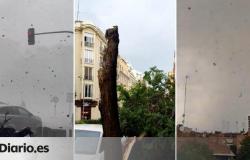The first thing you do when you arrive at the beach, even unconsciously, is look at the flag color this. In this way, the bather knows the state of the beach that day and how dangerous it is to bathe or simply be on the beach.
The NGO Ecologistas en Acción publishes an annual report with the number of beaches with a black flag, which is defined as “an urgent call for attention on the need to take effective measures to protect and adequately manage the natural resources of our coasts.” That is, unlike the blue flag, it is a discredit.
The 2024 report, which measures the state of all beaches and ports along the 8,000 km of Spanish coast, in addition to some of the most serious environmental conditions on the Spanish coast, establishes that in our country there are 48 black flags.
Of them, 10 belong to Andalusia, 6 to both Galicia and the Valencian Community and 3 to the Basque Country, these being the communities with the most black flags.
If we go with the classification for the reason of the black flag, we find ourselves with 16 per wastedeficiencies in sanitation systems and serious purification problems, 15 percent coastal urbanization6 per pollution (whether chemical, lighting and/or acoustic), 1 per damage al Interactive map location of historical and cultural heritage flags in DMPT, 3 per marine litter and dredging and port expansions without justification (respectively) and finally, 4 per affections to diversity.
The Ecologists in Action report establishes that Causes are not new, and he attributes this mainly to the concentration of tourists on the beaches Yet the urbanizationespecially in the Canary Islands.
They also attribute this problem to the plastic accumulation on the beaches, although they mention that “the dumping of plastic pellets that affected the Galician coast at the beginning of this year helped raise awareness about the seriousness of this problem and made visible how exposed our coast is to this type of disasters.”
In addition to the black flag, we can see four other colors on the beaches.
Green flag: bathing allowed
The green flag is the most recognized, and in the end the green and red mean the same as a traffic light. Therefore, green means that it is all in order and that you can bathe without apparent problem.
Yellow flag: bathe, but carefully
It’s a intermediate term between red and green, which means that you can bathe, but that you must be careful, since there is some danger. Therefore, the yellow flag implies that you should not reach the area where you cannot stand, and always have your head above water. Sometimes the yellow flag is accompanied by another white one with an illustration of two jellyfish, evidently warning of the presence of these animals in the water.
Red flag: bathing prohibited
As we have already mentioned, the color of the flags follows the same order as a traffic light, therefore, a red flag implies that It is prohibited to get into the water under any circumstancessince doing so implies a high risk for the bather.
These three colors refer to the state of the sea, while the next two refer to the state of the sea. beach state per se.
Blue flag
The blue flags are a recognition given annually by the European Foundation for Environmental Education to beaches that meet four requirements: quality of bathing water, environmental information and education for its users, environmental management, safety and services of said beach.
Spain is this year the country with the most blue flagss, 729, with the Valencian Community as leader.
Follow the Diario AS channel on WhatsApp, where you will find all the sport in a single space: the news of the day, the agenda with the latest news on the most important sporting events, the most outstanding images, the opinion of the best AS firms , reports, videos, and some humor from time to time.






